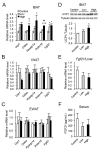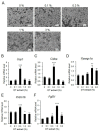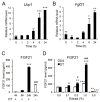Dietary Supplementation with Dunaliella Tertiolecta Prevents Whitening of Brown Fat and Controls Diet-Induced Obesity at Thermoneutrality in Mice
- PMID: 32516922
- PMCID: PMC7352257
- DOI: 10.3390/nu12061686
Dietary Supplementation with Dunaliella Tertiolecta Prevents Whitening of Brown Fat and Controls Diet-Induced Obesity at Thermoneutrality in Mice
Abstract
We investigated the effect of evodiamine-containing microalga Dunaliella tertiolecta (DT) on the prevention of diet-induced obesity in a thermoneutral C57BL/6J male (30 °C). It attenuates the activity of brown adipose tissue (BAT), which accelerates diet-induced obesity. Nine-week-old mice were fed a high-fat diet supplemented with 10 g (Low group) or 25 g (High group) DT powder per kg food for 12 weeks. Compared to control mice without DT supplementation, body weight gain was significantly reduced in the High group with no difference in food intake. Tissue analyses indicated maintenance of multilocular morphology in BAT and reduced fat deposition in liver in DT-supplemented mice. Molecular analysis showed a significant decrease in mammalian target of rapamycin-ribosomal S6 protein kinase signaling pathway in white adipose tissue and upregulation in mRNA expression of brown fat-associated genes including fibroblast growth factor-21 (Fgf21) and uncoupling protein 1 (Ucp1) in BAT in the High group compared to the control. In the experiments using C3H10T1/2 adipocytes, DT extract upregulated mRNA expression of brown fat-associated genes in dose-dependent and time-dependent manners, accompanied by a significant increase in secreted FGF21 levels. Our data show the ability of DT as a nutraceutical to prevent brown fat attenuation and diet-induced obesity in vivo.
Keywords: brown fat; fibroblast growth factor-21; microalga; obesity; thermoneutrality; uncoupling protein 1.
Conflict of interest statement
The authors declare no conflict of interest regarding the publication of this article.
Figures






References
MeSH terms
Substances
Grants and funding
LinkOut - more resources
Full Text Sources
Medical
Research Materials

